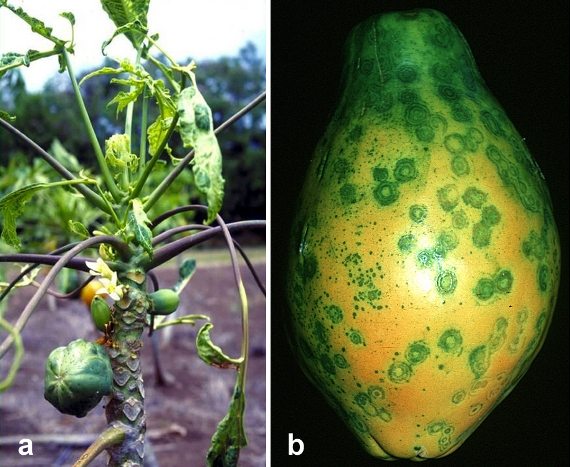
GM papaya Seed resistant to the Ringspot-Virus were introduced
In 1998, Rainbow papaya seed, a transgenic virus-resistant variety, were released to farmers, allowing farmers to cultivate this tropical fruit crop despite the virus being present in the environment. Papaya ringspot virus entered Puna, Hawaii’s major papaya growing area, in 1992, and by 1994 all farming areas in Puna, where up to 96% of Hawaii’s papaya crop was grown, had become infected.
Papaya ringspot virus is a killer. Once a plant is infected, it can never recover. Aphids feeding on the leaves of infected papaya trees effectively transmit the virus within seconds of probing on healthy trees. Symptoms begin to appear in about three weeks after infection. Young seedlings die quickly and never grow to produce fruit. Older trees develop yellowed leaves. They produce smaller and smaller fruit and are doomed to a slow death. The viral epidemic that occurred in Puna could not be stemmed by a statewide effort to remove all the infected trees in the area.
The Rainbow papaya is an F-1 hybrid variety of papaya produced by crossing Hawaii’s yellow-flesh Kapoho Solo variety with the red-flesh SunUp. Researchers from Cornell University and the University of Hawaii had done research since 1984 to develop this Rainbow variety, which includes a gene that made the papaya plants resistant to the ringspot virus—similar to the way a vaccine makes people immune to disease.
Farmers endured the scourge of Papaya ringspot virus a full six years, from 1992 to 1998, before Rainbow and SunUp were offered as a solution to their problem. Enthusiastic farmer acceptance of Rainbow documented in the 1999 farmer survey reported here shows the phenomenally high and rapid rate of adoption with 76% of the 93 farmers planting their Rainbow seeds.
Tags:
Source: American Phytopathological Society
Credit:
